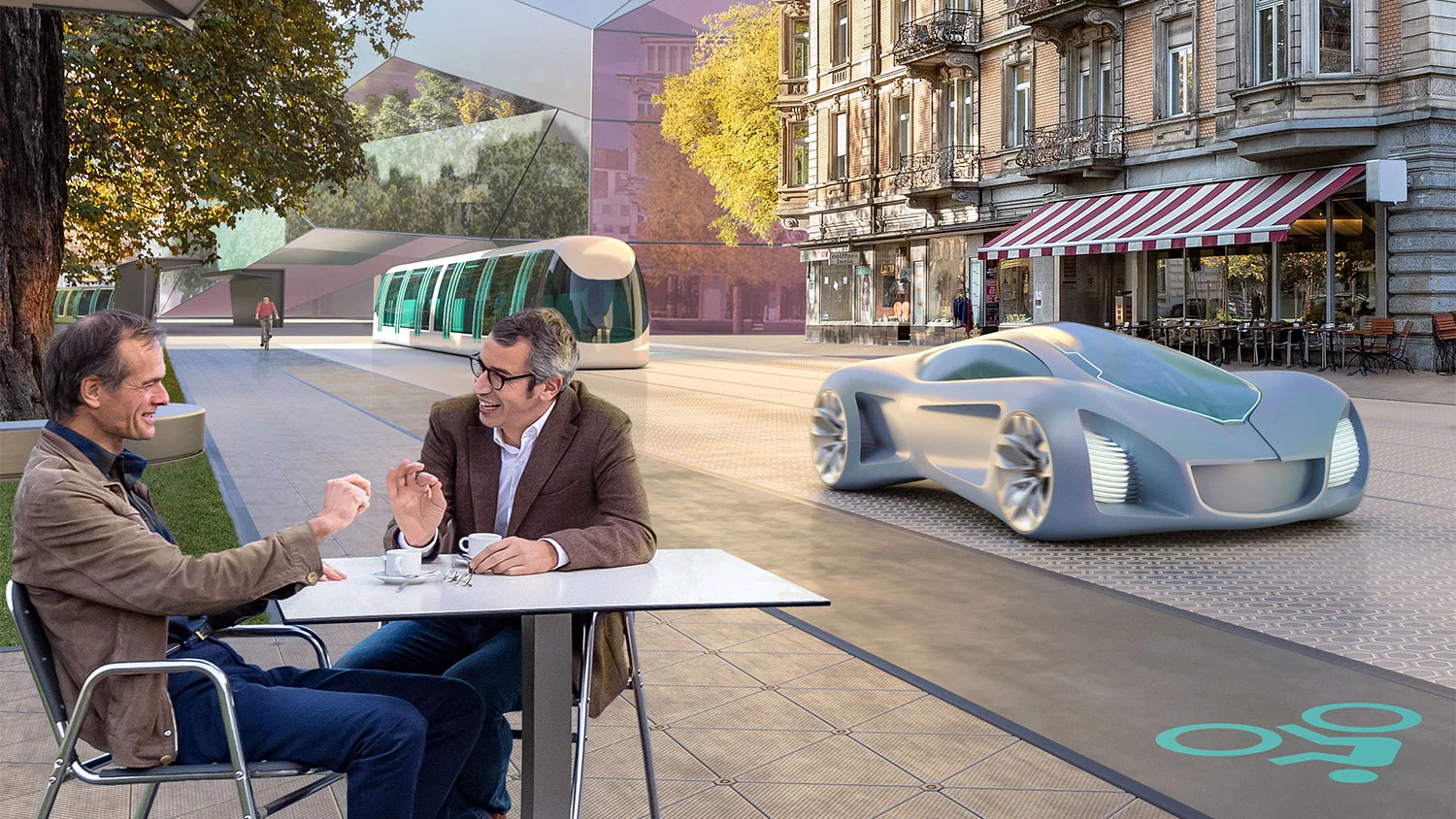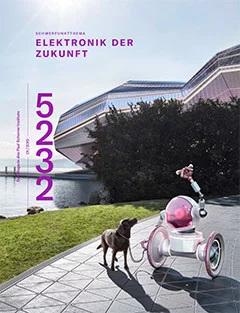If you make electronic components smaller, they unfortunately get hotter. Also, the limit of technically feasible miniaturisation will soon be reached. At PSI, Gabriel Aeppli and Christian Rüegg are working on fundamentally new, physical solutions for better computers and data storage devices.
Mr. Aeppli, Mr. Rüegg, what in your view is currently the greatest challenge in the development of electronics?
Gabriel Aeppli: One of the biggest problems is energy consumption. Today electronic data processing and the communications infrastructure require more energy than air transportation. If we go on this way, in ten or fifteen years information technologies will account for half of the total energy consumption.
Christian Rüegg: First, this is a societal problem, and second also a technical one. In consuming this energy, a lot of excess heat is generated – and the smaller you build these things, the hotter they get. That's just the laws of thermodynamics, basic physics.
Aeppli: Two additional problems: The basic element, that is, the individual electronic switches, are not going to get any faster. And because the whole thing is so complex, problems with security and reliability can arise.
Rüegg: When implementing artificial intelligence and self-driving cars, reliability can be crucial. If the computer at home crashes and has to be rebooted, that's merely annoying. Going down the highway at 120 kilometres per hour, it's a different kind of problem.
Aeppli: One more challenge is the commercial risk. The construction of a new chip factory costs between 10 and 20 billion US dollars today and will continue to become more expensive.
The problems seem to be numerous and immense.
Aeppli: That's why we're here! The fact that the challenges are so great makes the work so interesting. During the last forty years, it was like being on a highway. The one same idea was used to make the electronic components smaller and smaller.
Rüegg: Present-day electronics are based on normal transistors, which act like switches, and which can be switched to zero or one. By using other processes, you could reduce the complexity, because the individual parts themselves would be more complex. Up to now, problems had to be solved technically; instead, we want to find a clever physical solution.
Aeppli: Now it's really time for something new!
Up to now, problems had to be solved technically; we want instead to find a clever physical solution.
What does this new, clever solution look like?
Rüegg: There are two different areas: first, computing, and second, the storage of data. Each of these has its own idea for a solution. For data storage, researchers are searching for new materials. They would like to use exotic supermaterials that possess special magnetic properties to store data more rapidly and with less energy. At PSI, we are investigating which materials are in the running. For computing, it's clear: The unit that will be used in the future must be something different from the conventional zero-one transistor; it must have more than two states. As a solution, I see the construction of a fundamentally new computer based on the principles of quantum mechanics. There are many initiatives worldwide. We at PSI are contributing to this research.
Aeppli: Classical bits are, as mentioned, either 0 or 1. Quantum bits, so-called qubits, can be in a superposition state that is simultaneously 0 and 1. Quantum states have a much greater information density, and in principle they could enable a naturally parallel computing. That would be much faster than the classical parallel computing, which is achieved today in typical PC processors through a "multicore" architecture and facilitates, for example, having several tabs open at once in a browser.
Companies like IBM and Google already have prototypes of quantum computers, based on the phenomenon of superconductivity. Other approaches come from the fields of laser and atomic physics. Will it actually one day be possible to build a manageable quantum computer that replaces our conventional computers with their silicon chips?
Aeppli: In atomic physics laboratories, it looks a bit like at Christmas, with many lasers that are set up very precisely. At the moment, the dimensions are large and impractical. Also, for the superconducting machines, the qubits are relatively large, especially when you consider the need for very low-temperature refrigeration.
In my research, silicon is and remains the basis. If you want to implement quantum physics in a robust device, you have to resort to silicon – an ideal material, in which an extremely large amount of research has already been invested. And it is also well suited because it is a solid yet behaves in many respects like an incredibly clean vacuum. We exploit this property and use silicon as a trap for individual atoms. And such atom traps are the basis for qubits.
How far along are you in the development of such a silicon-based quantum computer?
Aeppli: Here at PSI we are concerned with the underlying physics. Colleagues in Delft in the Netherlands and at the University of New South Wales in Australia have succeeded in realising small quantum switches based on this principle. In parallel, other researchers, for example at ETH Zurich, are working on another technology based on superconductivity. We however think: silicon could represent not just the past, but also the future.
Will there be quantum computers inside our smartphones in ten or twenty years?
Aeppli: I think quantum coprocessors will at least solve subtasks. There won't be any complete quantum computers in our smartphones, but quantum properties will be exploited, for example, to solve the energy problem. Here at PSI, among other things, we are doing experiments to better understand how the electrons in computer chips behave. This behaviour is responsible for all electronic properties, including the switching of bits – regardless of whether they are classical or quantum mechanical. With the synchrotron Swiss Light Source SLS, we are now beginning to look directly at the electrons in thin layers of material. Soon we will also do this with the new X-ray laser SwissFEL.
Rüegg: Physically and in its approach, quantum technology is extremely exciting. But many steps still need to be made. As scientists, we can control some of these, others not – for example, the economic factors. That's why the interest of industry is important.
How do things stand with the collaboration between PSI and industry?
Aeppli: We profit from the fact that physics is now suddenly important again, because a new generation of fundamental research needs to be done. For a long time, the companies have been primarily concerned with systems and software. Now companies like Microsoft and Google are suddenly investing in hardware and not only collaborating with research institutes, but also carrying out basic research in their own labs, because the current problems can no longer be solved with software.
And how, precisely, is your collaboration with industry partners going?
Rüegg: We have joint research projects, but also contract research in which the industry partners conduct their experiments with our facilities and pay a fee for it.
Aeppli: Many of the projects are so applied that we are not even allowed to talk about them.
How do the PSI researchers feel about this secrecy?
Rüegg: Oh, in our research it's quite similar. If you have a great idea, there will always be competition and agreements. In Switzerland there are people working on digitalisation; we here at PSI are already working on digitalisation 2.0.
Interview: Barbara Vonarburg
About the scientists
Gabriel Aeppli is head of the Photon Science Division at PSI and a professor of physics at ETH Zurich and ETH Lausanne EPFL. Born in Zurich in 1956, he grew up in the USA and obtained a PhD in electrical engineering at the Massachusetts Institute of Technology (MIT). The Swiss-American double citizen spent a large part of his career in industry before he accepted a professorship in London in 2002 and became co-founder of the London Centre for Nanotechnology. In 2014 he returned to Switzerland.Christian Rüegg is head of the Research with Neutrons and Muons Division at PSI and a professor at the University of Geneva. He attended the Old Canton School of Aarau, studied physics at ETH Zurich, and subsequently worked for six years at the London Centre for Nanotechnology then headed by Gabriel Aeppli. Since 2011, Christian Rüegg is back in the Aargau at PSI. His current research on quantum magnetism is funded by the European Research Council.


